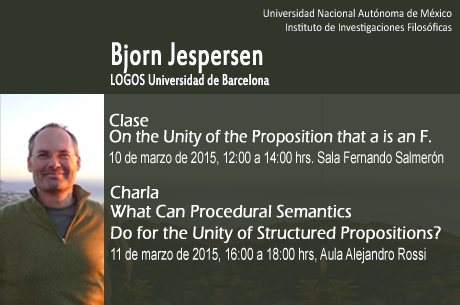Sesiones: Bjorn Jespersen
|
|
|
|
Clase ABSTRACT OF TUTORIAL This talk addresses the unity of the structured atomic proposition that a is an F. I address both the metaphysical problem of how multiple, heterogeneous parts are unified into one whole that has features none of its parts have, as well as how to decompose the whole back into its parts, and the semantic problem of how propositions are related to truth-conditions. I analyze both an empirical and a non-empirical (e.g. mathematical) variant of the proposition that a is an F; for instance, that Pluto is a planet, and that two is prime. The solutions I offer are developed within a realist procedural semantics (Transparent Intensional Logic), which identifies meanings with procedures for obtaining output objects from input objects. My general approach is broadly Fregean, but makes do without the notion of unsaturated objects. I demonstrate how predication holds the key to the unity of at least atomic propositions. Predication is modelled as an instance of the logical procedure of functional application.
1. B. Jespersen: Recent work on structured meaning and propositional unity, Philosophy Compass, vol. 7 (2012), 620-30. 2. M. Duží and B. Jespersen: Transparent quantification into hyperintensional objectual attitudes, Synthese, DOI: 10.1007/s11229-014-0578-z, 1-43. 3. L. Keller: The metaphysics of propositional constituency, Canadian Journal of Philosophy, vol. 43 (2013), 655-78. |
|
|
Charla
What Can Procedural Semantics Do for the Unity of Structured Propositions? ABSTRACT OF LECTURE
This talk explores what procedural semantics can do for the twin notions of structure and unity. Procedural semantics construes linguistic meaning as a procedure that delineates which objects of which type operate on which other objects of which type so as to yield which yet other objects of which type. I conceive of a multi-part structure as an interlocking system of objects. The two main sources of inspiration are Frege’s notion of Sinn and procedural semantics as known from computer science, where it contrasts with denotational semantics. The contrast, in broad terms, is the contrast between an intensional and an extensional conception of meaning. |
Aviso de privacidad




 Circuito Maestro Mario de la Cueva s/n, Ciudad Universitaria, C.P. 04510, Coyoacán México, CDMX
Circuito Maestro Mario de la Cueva s/n, Ciudad Universitaria, C.P. 04510, Coyoacán México, CDMX